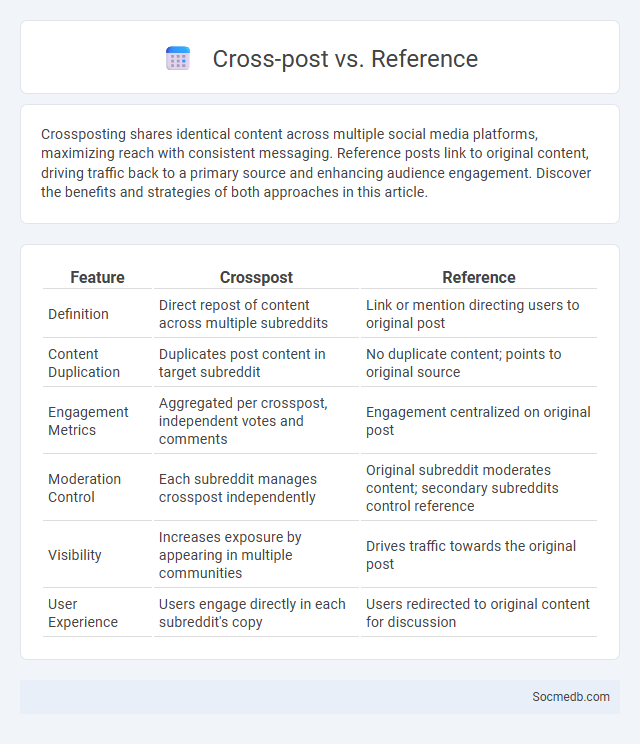
Photo illustration: Crosspost vs Reference
Crossposting shares identical content across multiple social media platforms, maximizing reach with consistent messaging. Reference posts link to original content, driving traffic back to a primary source and enhancing audience engagement. Discover the benefits and strategies of both approaches in this article.
Table of Comparison
| Feature | Crosspost | Reference |
|---|---|---|
| Definition | Direct repost of content across multiple subreddits | Link or mention directing users to original post |
| Content Duplication | Duplicates post content in target subreddit | No duplicate content; points to original source |
| Engagement Metrics | Aggregated per crosspost, independent votes and comments | Engagement centralized on original post |
| Moderation Control | Each subreddit manages crosspost independently | Original subreddit moderates content; secondary subreddits control reference |
| Visibility | Increases exposure by appearing in multiple communities | Drives traffic towards the original post |
| User Experience | Users engage directly in each subreddit's copy | Users redirected to original content for discussion |
Understanding Crossposting: Definition and Purpose
Crossposting involves sharing the same content across multiple social media platforms to maximize reach and engagement. This strategy enhances brand visibility by connecting with diverse audiences on platforms like Facebook, Instagram, Twitter, and LinkedIn. Marketers use crossposting to save time while maintaining consistent messaging and increasing interaction rates across channels.
What is Referencing in Content Sharing?
Referencing in content sharing on social media involves citing or linking the original source of information, images, or ideas to maintain credibility and respect intellectual property. Proper referencing enhances content authenticity, encourages transparency, and fosters trust among followers and collaborators. Platforms such as Instagram, Twitter, and LinkedIn support tagging and hyperlinking features that facilitate effective referencing practices.
Key Differences Between Crosspost and Reference
Crosspost involves sharing the same content across multiple social media platforms or accounts, maintaining original engagement metrics like likes and comments, thus consolidating audience interaction. Reference, on the other hand, creates a linked or tagged post that directs followers to the original content without duplicating it, preserving content authenticity and clearly attributing the source. Understanding these key differences enhances content strategy by balancing reach expansion through crossposting and credibility maintenance via referencing.
Use Cases for Crossposting
Crossposting on social media enables you to maximize content reach by sharing posts across multiple platforms such as Facebook, Instagram, and Twitter simultaneously. This strategy enhances brand consistency and saves time by avoiding duplicate content creation. Leveraging crossposting ensures your audience receives timely updates regardless of their preferred social network, boosting engagement and visibility.
When to Use Reference Instead of Crosspost
Use reference posts on social media when maintaining the original engagement metrics, such as likes and comments, is crucial for brand visibility and credibility. Reference posts help consolidate audience interaction on a single post instead of splitting engagement across multiple posts, ensuring a stronger social proof effect. Crossposting is better suited for reaching different audience segments, while referencing preserves the primary content's influence and analytics.
SEO Implications: Crosspost vs Reference
Crossposting content on multiple social media platforms can dilute SEO value by creating duplicate content, which may negatively impact your search rankings. Referencing original posts instead of crossposting helps consolidate backlinks and user engagement to a single source, enhancing your content's authority and search visibility. To optimize SEO, your strategy should prioritize referencing to maintain unique content and strengthen your site's overall domain relevance.
Best Practices for Crossposting Across Platforms
Maximize your reach by tailoring content to the unique audiences and formats of each social media platform while maintaining consistent branding. Use scheduling tools to post at optimal times and avoid duplicate content penalties by customizing captions and hashtags for each channel. Monitor engagement metrics regularly to refine your crossposting strategy and ensure your message resonates across Facebook, Instagram, Twitter, LinkedIn, and TikTok.
Legal and Ethical Considerations
Social media platforms must comply with privacy laws such as GDPR and CCPA to protect users' personal data from unauthorized access or misuse. Ethical considerations include ensuring transparency in content moderation, avoiding misinformation, and respecting intellectual property rights to maintain trust and integrity. Your awareness of these legal and ethical standards helps safeguard your online presence and promotes responsible digital communication.
Enhancing Engagement: Choosing the Right Method
Enhancing engagement on social media requires selecting the right method tailored to your target audience's preferences and behaviors. Utilizing interactive content such as polls, quizzes, and live videos significantly boosts user interaction and fosters community building. Your strategy should prioritize consistent, authentic communication and data-driven insights to maximize engagement effectively.
Crosspost or Reference: Which Strategy Fits Your Goals?
Crossposting maximizes content reach by sharing the same post across multiple social media platforms, increasing visibility and engagement without creating new content. Referencing involves linking or mentioning related content, which boosts credibility and drives traffic by encouraging audiences to explore connected posts or profiles. Selecting between crosspost and reference strategies depends on whether your primary goal is broad exposure or deeper audience engagement through curated, relevant connections.
 socmedb.com
socmedb.com